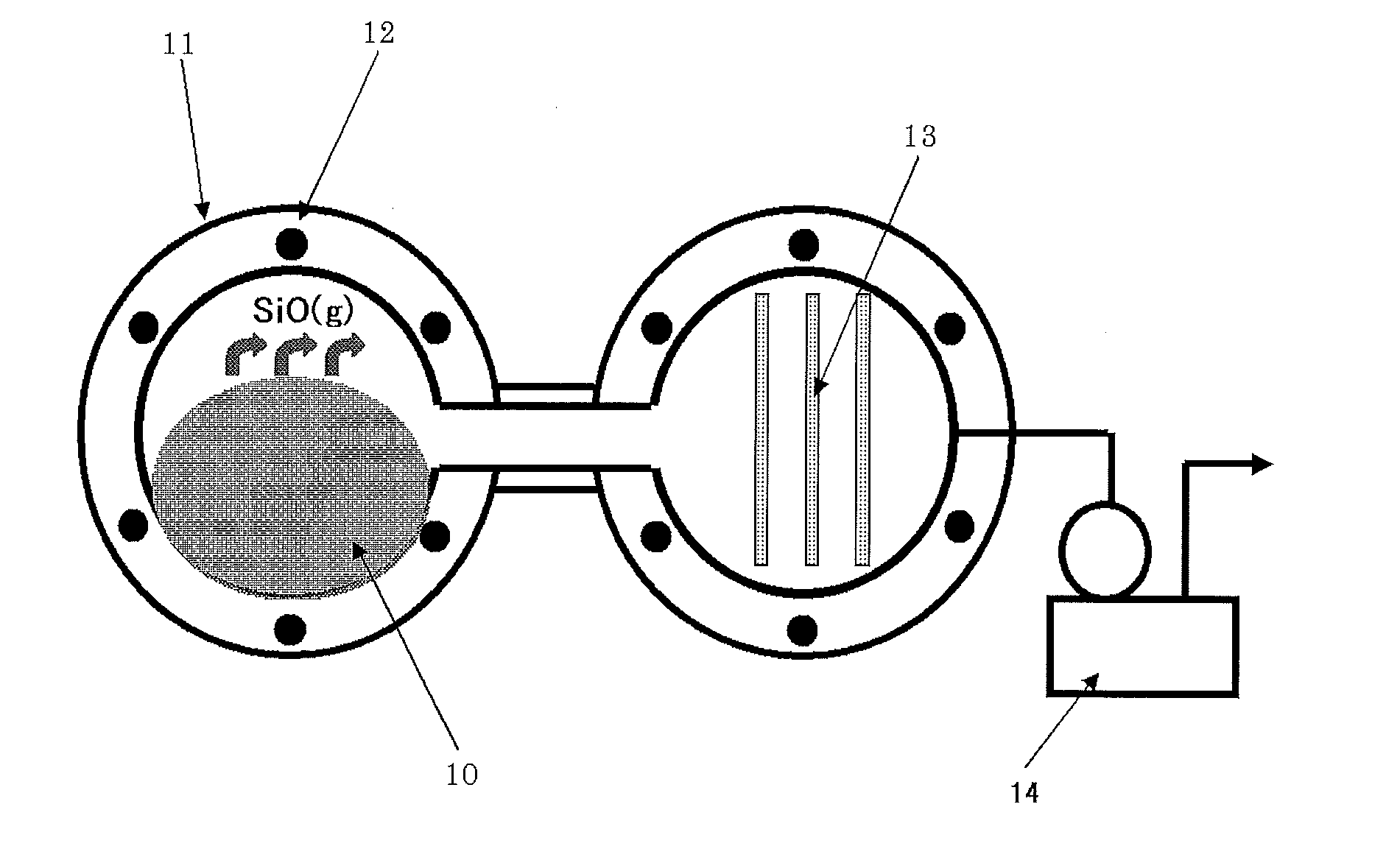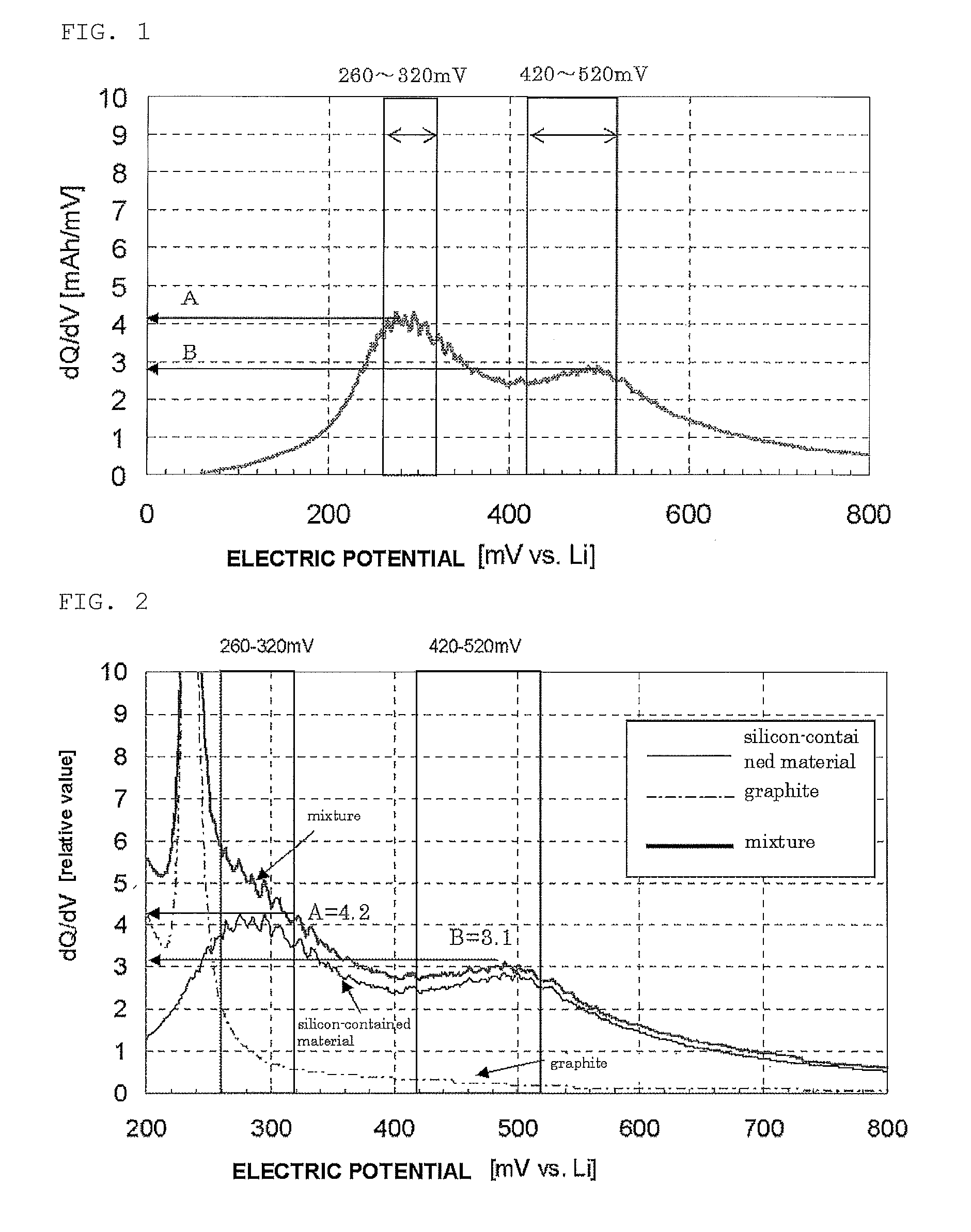Silicon-contained material, negative electrode for use in non-aqueous electrolyte secondary battery, method of producing the same, non-aqueous electrolyte secondary battery, and method of producing the same
- Summary
- Abstract
- Description
- Claims
- Application Information
AI Technical Summary
Benefits of technology
Problems solved by technology
Method used
Image
Examples
example 1
[0114]A reactor as shown in FIG. 7 was used. This reactor included a furnace 11, a heater 12, stainless steel bases 13 for precipitation, and a vacuum pump 14. Raw material powder 10 was introduced into the furnace 11. Specifically, fumed silica having an average particle size of 0.05 as silicon dioxide powder, and metallic silicon having an average particle size of 5 μm pulverized with a jet mill, as metallic silicon powder, were mixed in a metallic silicon powder-to-silicon dioxide powder mole ratio of 1.01. The obtained mixed powder was placed in the furnace 11 and heated at 1,420° C. under a reduced pressure of 40 Pa to generate silicon monoxide gas. The generated silicon monoxide gas was precipitated on the stainless steel bases 13, so that a silicon oxide lump was obtained. The obtained silicon oxide was pulverized with a ball mill, so that silicon oxide powder (SiOx where x=1.02) having an average particle size of 5 and a BET specific surface area of 4.8 m2 / g. After 200 g of ...
example 2
[0121]After 200 g of the same silicon oxide powder as example 1 was set on a silicon nitride tray, this powder was left in a furnace that can maintain the atmosphere; the powder was SiOx having an average particle size of 5 μm, and a BET specific surface area of 4.8 m2 / g where x=1.02. Then, argon gas was introduced into the furnace to replace the interior of the furnace with an argon atmosphere. The temperature in the furnace was increased at a heating rate of 300° C. per hour while a mixed gas of methane and argon was introduced at a rate of 2 NL / min. The temperature was maintained within the range from 600° C. to 1,000° C. for 3 to 10 hours, so as to perform thermal chemical vapor deposition (CVD) for a carbon coating. After the maintenance, the temperature was decreased until the temperature reached room temperature. The powder was then taken out. The amount of the deposited carbon of the obtained conductive silicon composite powder was in the range from 5.3% to 18.5%.
[Battery Ev...
example 3
[0123]The silicon-contained material in examples 1 and 2 was made of silicon oxide powder, subjected to the heat treatment and coated with carbon. Whether a high cycle performance effect of the invention can be achieved was checked even when another element was added. In production of a battery, conductive silicon composite powder that was doped with lithium in advance was produced. Lithium may be used to improve the first efficiency. Specifically, the conductive silicon composite powder (sample 10) having a B / A value of 0.65 obtained in example 2 and 5% of metallic lithium were added to an organic solvent and the resultant was mixed. The mixture was then dried. This obtained conductive silicon composite powder doped with lithium was heated at a heating rate of 300° C. / hour under an argon gas atmosphere and the temperature was maintained within the range from 500° C. to 800° C. for 3 to 8 hours.
[Battery Evaluation]
[0124]The battery with the obtained conductive silicon composite powd...
PUM
 Login to View More
Login to View More Abstract
Description
Claims
Application Information
 Login to View More
Login to View More - R&D
- Intellectual Property
- Life Sciences
- Materials
- Tech Scout
- Unparalleled Data Quality
- Higher Quality Content
- 60% Fewer Hallucinations
Browse by: Latest US Patents, China's latest patents, Technical Efficacy Thesaurus, Application Domain, Technology Topic, Popular Technical Reports.
© 2025 PatSnap. All rights reserved.Legal|Privacy policy|Modern Slavery Act Transparency Statement|Sitemap|About US| Contact US: help@patsnap.com



